The Mike Toole Show
This One's About Car Racing Anime
by Mike Toole,
Last year at Otakon, I was presented with a rare opportunity: a friend of a friend had offered to drive me through the rain back to my hotel. That's a pretty tempting offer by itself, but the real offer was that this new acquaintance walked us back to his car, deep in the parking garage under the Walter E. Washington Convention Center, and his car just happened to be a genuine 1985 Toyota Corolla GT-S, better known to anime dorks as the Toyota AE86 Trueno: the Initial D car!
I'm a big guy, but I didn't hesitate to squeeze into the passenger seat of the car. The driver obligingly put on “Space Boy” by Dave Rodgers, one of Initial D's many surging, giddily uptempo Eurobeat anthems, and sedately proceeded up the ramps to the garage's exit. Of course; what was I expecting? The car I was riding in was still a 33-year-old Corolla, not exactly in mint condition, and we were heading up to Massachusetts Avenue, not Mt. Akina. I settled in and watched the rain as the gate lifted, and that's when the driver punched it, surging up the final ramp to the street, spinning the wheel deftly, then spinning it twice as hard as we leveled off. The car's engine sang, the rear-wheel drive powered us forward, and as the oversteering kicked in, for just a split second, we were drifting along at a neat 45-degree angle. Turns out anime cars are real!

Every single good auto racing anime has to do one thing well, and that's to examine its cars with a nearly fetishistic level of detail. Initial D always delivered in that respect, whether it was protagonist Takumi Fujiwara's family AE86 or his competitor Ryosuke Takahashi's lily-white Mazda RX-7 Turbo. Despite the anime version's cheap-looking CG, the cars always felt real. This studied approach to machinery makes up the foundation of all mecha anime, and the approach stretches all the way back to the original hot-ass car racing anime, Speed Racer. I mean, you can just imagine the title character, can't you? Yep, just think for a second, and that winning smile, signature helmet, and blue jersey comes right to mind.
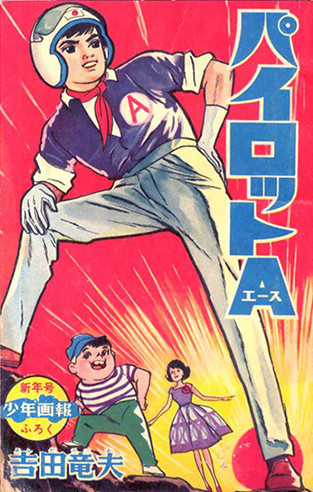
Ah… yes..,? This driver should look familiar to you, but he's not Speed Racer, a.k.a. Go Mifune. This dashing young champion of the racing circuit is none other than Eiichi Yamada, driver of the experimental supercar called Ace. The three Yoshida Brothers who would go on to found Tatsunoko Production really left their mark on the anime industry, but it's important to remember that they were also cartoonists long before the studio kicked out their first animated hit, Space Ace. Eldest brother Tatsuo launched Pilot Ace, the adventures of Eiichi and his Maserati-looking supercar, in the pages of the biweekly Shonen Gaho in 1960. The manga ran for a few years— even now, you can get snappy reprints via the Japanese publisher Manga Shop. Yoshida's little brother Toyoharu, a.k.a. Ippei Kuri, obligingly followed his sibling's lead, launching a racing manga of his own called Mach Sanshiro.
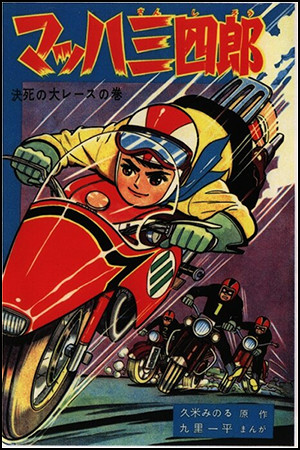
Can you spot the difference? Kuri's manga is about a slick motorcycle, the Golden Arrow, rather than a high-tech car. Also, while Pilot Ace has a lot of the stuff we'd see in Speed Racer, including a smart, clever love interest and an irascible little brother, it had a few differences—Eiichi's dad, for example, designs the Ace, much like Speed's dad Pops builds the Mach V. But the Pilot Ace dad is more like a classic mad scientist than a beefy mechanic. The dad/mechanic figure of Sanshiro Hayafune, protagonist of Mach Sanshiro, is the guy below. Ah, we're back in familiar territory.
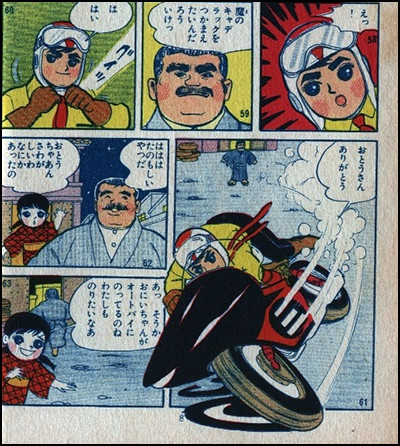
A few years down the road, the Brothers Tatsunoko would combine elements of these hit manga series to create… a new manga, called Mach GoGoGo. The difference is, according to the eldest Yoshida, Mach GoGoGo was created with a TV version in mind. It'd take a little time for that TV version, the swingin, colorful eternal megahit Speed Racer, to appear, but the manga is a compelling and peculiar artifact. Due to Yoshida's incredibly strong linework and straightforward, almost dour plotting, it reads like an absolute blueprint of the eventual TV series; reading it is kind of like reading especially good, detailed storyboards. The eventual animated version was a benediction for an entire global generation of anime viewers, whose imaginations were revved up by the show's colorful visuals, violent crashes, sibling rivalry, and weird, creepy villains. At the center of things was the Mach V supercar, obviously; the Yoshida Brothers understood the need for this intuitively. Episodes would begin with Speed breathlessly describing the features of his family's awesome race car, revealing them one by one. Later, the titular hero would square off against even weirder automotive units, like a team of stunt drivers adept at flipping and stacking their rides, the Car Acrobatic Team, and a car that goes so fast it drives Speed crazy with fear. Man, that was a good show.
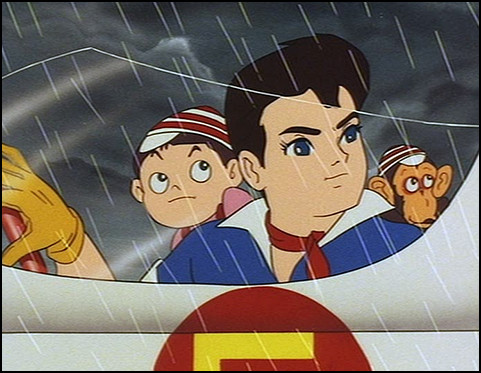
You'd think that Speed Racer would be something that Tatsunoko would be eager to extend and revive endlessly, like their later Time Bokan series. They did try to go back to the well, notably in 1969 with a failed project called Skyfighter Z. Absent a uniquely crummy American-made cartoon, the Mach V stayed in the garage… until 1997, when original series director Hiroshi Sasegawa took up his mighty pen, and… directed one of those crummy 90s Tatsunoko remakes. You remember how Gatchaman, Hurricane Polymar, and Casshan all got really cool-looking but weirdly empty, perfunctory OVA reduxes? Yeah, the Speed Racer version was kinda like those, featuring slightly sideways re-imaginings of the original cast of Speed and friends. Mach GoGoGo 1997 didn't have a whole lot of gas in the tank, and a time-travelin' alien-fightin' twist didn't excite audiences, so the series was quietly canceled after 34 episodes. Needless to say, master US licensor Speed Racer Enterprises fast-tracked this version for US release, which means that it never really got done. A single pilot episode, entitled Speed Racer Y2K, was screened at the San Diego Comicon, clumsily slapped onto a shovelware CD-ROM “Speed Racer: The Ultimate Guide!” release, and then never really seen again.
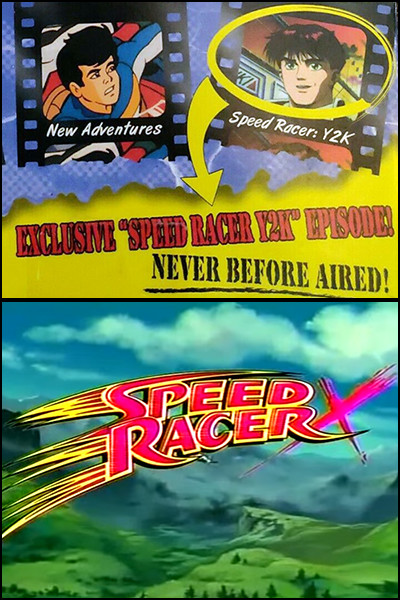
Fortunately, DiC came to the rescue, brokering a deal with Speed Racer Enterprises to dub the 1997 series under the title Speed Racer X. Thirteen episodes of this weird magic, which featured Trixie as a news reporter, Spritle as her little brother, and Speed working under the auspices of Hibiki Motors, rather than the original Mifune Motors, was set up to air on Nickelodeon's brand new SLAM! action block. Then, two things happened: first of all, Nick abruptly yanked the SLAM block after a few months, which means those thirteen episodes aired exactly once. More interestingly, DiC suddenly sued Speed Racer Enterprises, accusing the licensor of inking a bad deal with them. In the end, nobody got Speed Racer X – it never returned to TV, never got finished, and never got released on video. All that was left to Speed Racer Enterprises was a series of weird-looking western cartoon spinoffs, culminating in Speed Racer: Race to the Future, an Indian-animated OVA that was completed right before SRE returned the rights to the characters and trademarks to Tatsunoko. (Note: They did so under duress, after some legal action. One wishes Tatsunoko took the same approach to Harmony Gold with the original Macross…)
We all know about that rad movie version of Speed by the Wachowski Sisters, but it's odd to stop and consider that Speed Racer as an anime thing pretty much stopped after Speed Racer X—except, of course, for Mach Girl. What, don't you remember Mach Girl?! Come on, it ran on Cartoon Network and everything! Feast your eyes on the hippest anime heroine of 2007, baby:
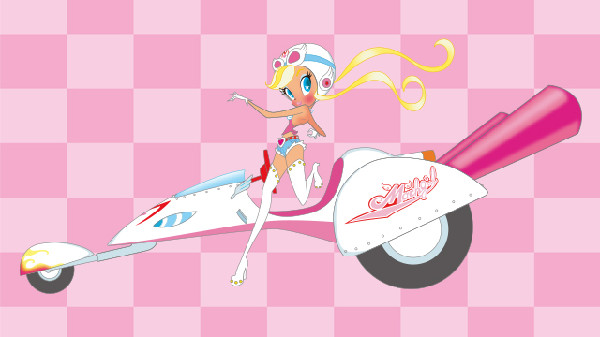
Needless to say, while our speedster above, Lip, seems pretty cool and cute, the ganguro look was a bit dated by the time 2007 rolled around. The series keeps it simple and is solid fun, playing like a slightly noisier, more colorful Perils of Penelope Pitstop. Lip's overstated gyaru look is probably what kept the series from heading west. Beyond Mach Girl, Tatsunoko have promised to resurrect this series in recent years, but while protagonist Go Mifune has a big old cameo, in cowboy(!) form, in the peculiar theatrical film Pandora & Akubi, which is a bizarre crossover between smash hit mobile game Monster Strike and Tatsunoko's Hakushon Daimaōh series, a proper Speed Racer redux hasn't happened yet.
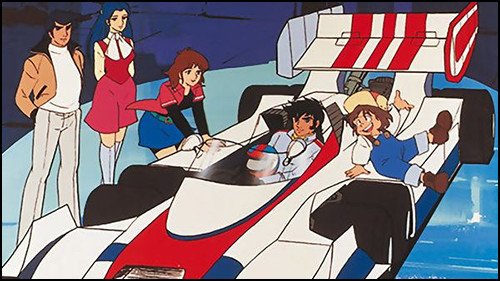
The original Speed Racer got the engine running on great auto racing anime in the 60s, but the real anime racing boom wouldn't happen until the mid-1970s. In fact, a few months back, one of the great intersectional heroes of Japanese animation and motor sports passed away. I'm talking about a driver from Austria named Niki Lauda, who spent a significant portion of the 70s as the top-ranked precision race driver in the world, an already-legendary competitor when he almost burned to death in a fiery crash in 1976. But Lauda came back… to appear in Arrow Emblem - Hawk of the Grand Prix, a flamin' hot TV anime about a hot-blooded racecar driver named Takaya (“Taka” means “Hawk,” get it?!) Todoroki, who must overcome his anxieties after a harrowing training crash to become a champion Formula 1 racer. Who better to train him than tenacious crash survivor Niki—well, wait a minute, let's take a look at the guy.
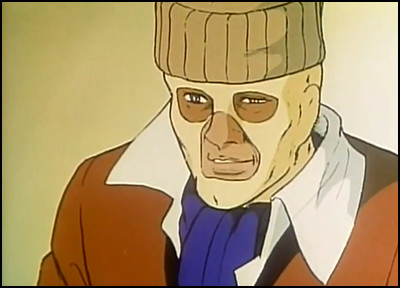
“Ever heard of Niki Lauda?” the mysterious masked man inquires, upon first meeting Todoroki. “Well, I am definitely not him. I am a completely different Formula 1 champ named Nick Lambda.” Yeah, he ain't fooling anybody, so much so that a later English-dubbed version simply shrugged and went ahead with calling the character Niki Lauda. But 70s anime is lousy with sports cameos. Lupin the 3rd had Pele, Tiger Mask had Andre the Giant and Antonio Inoki and plenty of others, and Arrow Emblem has not just a very slightly ersatz Niki Lauda, who is curiously gregarious and engaged with Takaya, personality traits notably at odds with the real-life Lauda's well-known standoffishness, but its own humorously off-center cameos by the likes of Mario Andretti and Emerson Fittpaldi. Yep, that's them below, all right.
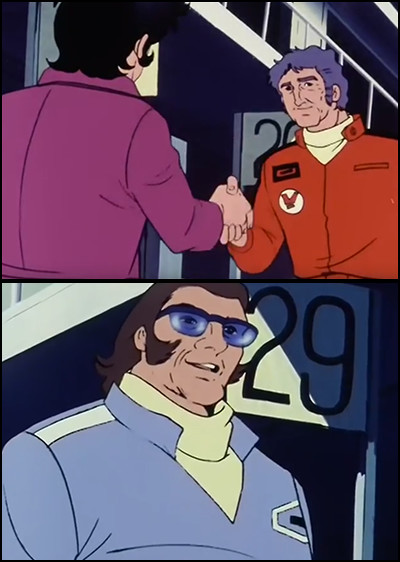
Arrow Emblem was a pretty cool anime about racing cars, with Takaya rounding into form as he completes in a global F1 circuit, but it was also part of a bona fide anime supercar boom. The anime world is just as susceptible to social trends as any other media—just think about it, the volleyball anime boom was sparked by famous Olympic victories, the soccer anime boom was kicked off (ha!) by the 2002 World Cup, and of course, the motorized mini-4WD toy car anime boom was kicked off by a line of toys. (Note: this boom consisted of exactly two shows, Dash! Yonkurō and Racing Brothers: Let's & Go!) The supercar boom coincided with the real-life 1976 Japanese Grand Prix, a race in which Lauda and Andretti starred. The anime boom included three other shows—Machine Hayabusa, Supercar Gattiger, and Luben Kaiser. These are all pretty interesting artifacts of the time, but for my money, Machine Hayabusa is the best of the bunch. Why, you ask? Well, it takes the reliable old trope of a racing team, and makes the main car a beefy F1 racer with a jet engine strapped to the top. No, that's literally exactly what it is, see?
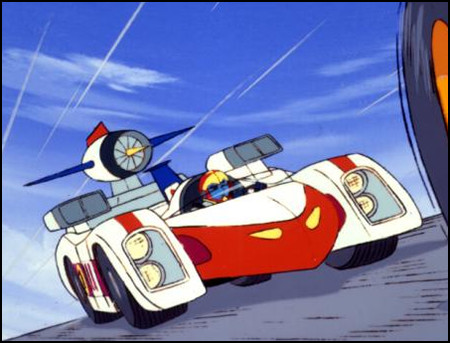
Told ya. If you're wondering whether or not the car can fly, of course it can! Machine Hayabusa is the story of Ken Hayabusa's valiant struggle against the Black Shadow group, who control the world of high-performance auto racing. How does Ken face the bad guys? With the help of his Saionji Racing Team pals, his powerful car, and his skills on the track. This series was originally created as a collaboration between Wild 7 manga creator Mikiya Mochizuki and Gō Nagai's studio Dynamic Planning, and it's just as enjoyably nutty as you'd think it would be, an ingratiatingly straight-faced, swaggering fusion of Thunderbirds and Wacky Races. Let's load up Ken and his pals' cars (the other cars have wacky gimmicks too, obviously) in the weird giant truck, nicknamed Big Garry, and head off to the next adventure! Machine Hayabusa was almost directed by Yoshiyuki Tomino, as well, but he ended up doing Zanbot 3 instead, while Yūgo Serikawa took the reins of Hayabusa. I would've liked to have seen Tomino's take on this material, but his absence no doubt cut down the amount of oddly compelling body language and the total number of fiery car crash deaths in this show.
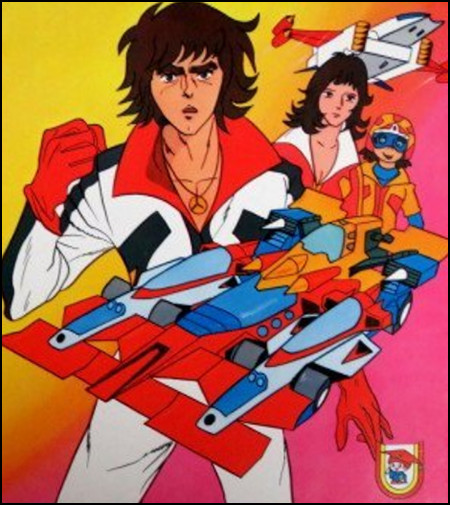
Then there's Cho Supercar Gattiger (translator's note: “Cho” means “Super”). This one is easily the weirdest entrant in the supercar anime Grand Prix, and one of the most peculiar shows of its time. The two ad agencies sponsoring Gattiger pose a question to viewers: what if, instead of one totally awesome high-speed race car, you had five weird racecars, who can combine into a somewhat larger and weirder car?! You have the Supercar, Gattiger, is what. This series absolutely feels like a super robot show, only the robot happens to be a car. This notion is only bolstered by the drivers, who consist of Hot-Blooded Leader Guy, Quiet Smart Guy, Big Strong Guy, Little Kid, and Girl. (Note: the girl character's racing uniform includes a skirt, and the kid brings his pet hawk in the cockpit like a damn maniac.) These brave drivers, who call themselves the Tiger Team, face off over and over against the most powerful auto racing concern in the world—the Demon Car Company! The Demon Car Company (NASDAQ: DCAR) is led by its powerful and resourceful CEO, Black Demon. You know he's the bad guy because he wears a hat with snakes on it. Man, I love the idea of evil, shadowy organizations controlling and manipulating global sporting events. It's so wacky and farfetched! Welp, back to watching the soccer world prepare to qualify for the next FIFA World Cup.
Anyway, Gattiger is not to be confused with the Gattiger robot of Gō Nagai's War of the Flying Saucers movie, which really messed up my attempts to research this series. (It doesn't help that the robot Gattiger recently got a really kick-ass die-cast toy, giving me a bad case of Toy Envy.) One interesting wrinkle about Super-Super Car Gattiger is that it aired in its entirety in San Francisco's bay area, with big blocky white subtitles, on KEMO channel 20's “Fuji TV” block. I only know this because there are rips of these episodes floating around the internet, complete with title cards identifying a licensor named Space Joe.
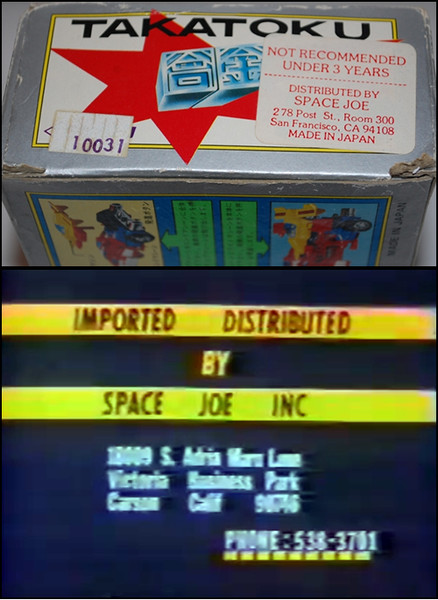
Upon seeing this, I wasn't just instantly outraged that I hadn't thought of a company name as good as “Space Joe,” I was also curious. It turns out that, like most anime of the time, this deal was an exercise in selling toys. Space Joe may have had a hand in getting Gattiger on TV in exactly one market, but their main deal was importing the cool Gattiger toys, slapping their sticker on them, and shipping them out to toy stores. Not a whole lot of people remember the Gattiger anime—it only seemed to pick up a persistent fandom in Italy, and to this day there's no DVD release in Japan—but toy collectors for damn sure remember the Gattiger toys; the main toys from Takatoku are sought after to this day.
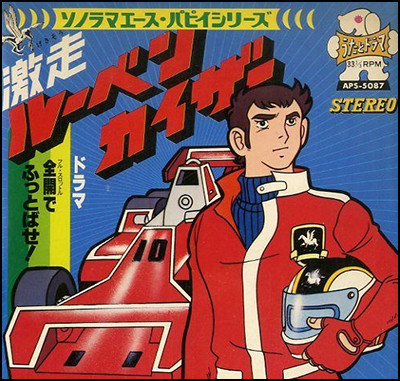
The final anime of the supercar boom is its most mysterious. Toei's Vroom! Luben Kaiser is a seemingly straightforward deal about an F1 racer with a muscular, bright-red car. It ran for seventeen episodes, which is a weird number until you remember that it was basically a year after the Tokyo Grand Prix at that point, and the fad was fading fast. I'd love to tell you more about Luben Kaiser, but I can't. You can't see it. Not only is it kind of a pain in the ass to research (opinions vary on whether it should be “Luben” or “Ruben,” or “Kaiser or “Kaizar,” or “Gekisou!” or “Vroom!”), it never got a home video release of any kind, so most of its data is just stuff gleaned from early-80s magazines and fan memories. Episode 4 was on YouTube at one point, but it's been gone for some time, and whispers of a long-awaited DVD or BD restoration have yielded nothing so far. If anyone finds an episode, send it my way, would you? Be on the lookout for that Pink Lady anime, while you're at it.
One interesting wrinkle of anime's supercar boom is that three of the four shows—Arrow Emblem, Gattiger, and Luben Kaiser—all hit the airwaves in the fall of 1977. In that sense, they were literally competing against each other. Machine Hayabusa made it to the race early, but didn't become an outsized hit. Of the four shows, only Arrow Emblem went the distance; the rest were gone inside of a year, with Luben Kaiser crashing the quickest. One thing unites all the anime of the supercar boom, though: they each had bitchin' theme songs.
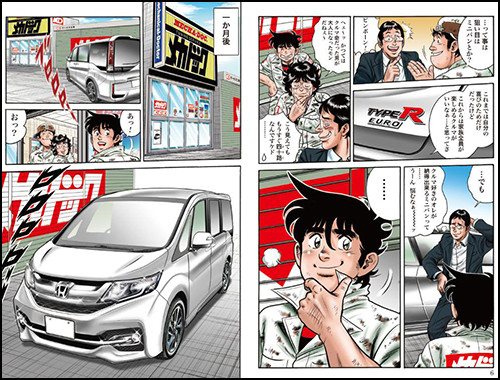
Of course, there have since been plenty of other auto racing anime. I was chilling with a buddy earlier this year, who told me about how they were working their way through watching the TV anime Yoroshiku, Mecha-Doc. Hearing that title stopped me dead in my tracks, because I couldn't place it. It's probably a testament to my obsession that this doesn't happen too often these days, but I couldn't recall or identify the series at all. I mean, Josephine the Whale? Of course, that's a classic. Jim Button? Obviously, I'm gonna remember that one. Miracle Girl Limit-chan? I mean, who could forget Satomi's awesome cyborg powers?! But I couldn't remember Mecha-Doc; was it another anime about racing? Not precisely— racing, both street- and professional, is an important part of Mecha-Doc's formula, but it's actually about tuning cars. Instead of a bright and charismatic racer, our hero Jun is a bright and charismatic mechanic, who busies himself turning a salvaged Toyota Celica into a competitive machine. His allies include the shop's talented bookkeeper and welder, and his big quest is to build a car that can beat out rival tuning shops' fleets of Nissans, Mazdas, and that one crew of broke-ass yankiis with a hilarious jalopy. The anime version isn't just characterized by the high detail on cars, which is obviously present in the source manga, but by using realistic car engine noises—you can really tell the difference between the show's cars just by listening! I hope this series is rediscovered at some point; it's somehow still relevant in Japan, where the characters of Mecha-Doc appeared in an ad campaign to endorse the Honda STEP wagon a few years back.
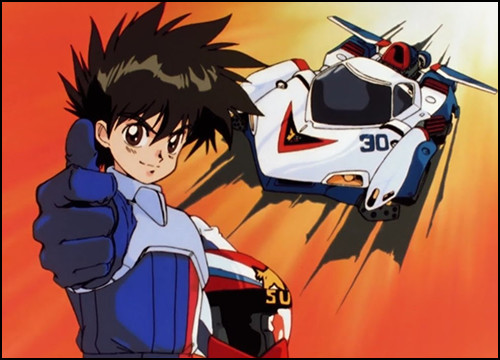
More recent entrants in the great anime motor sports race have been a little sparse, at least in terms of competitive track-racing. (Initial D would be an obvious choice, but that's a street racing deal, and a big enough phenomenon that it needs its own column, which I'm pointing out because I totally haven't seen those recent movies yet…!) A lot of 90s kids in Asia grew up enjoying 1991's Future GPX Cyber Formula, but I missed the starting flag on that one. The series sports an intriguing hook to go with its bold, brightly-colored futurism; in the coming year of 2015 (ha!), Formula 1 racing is boosted to new heights by the development of Cyber Systems, artificially intelligent on-board computers that don't just provide driver feedback and assistance, but can also make discrete changes to the car's suspension and tuning in real time. The best drivers aren't just skilled wheelmen, they need good technology backing them up and an excellent connection with their Cyber Systems. One aspiring champion is Kazami Hayato, a teenager whose close rapport with his Cyber System buddy, Asurada, gives him an advantage on the track—but he'll still need guts, practice, and the support of his team to win.
In this neck of the woods, being a Cyber Formula fan was a tough race, because the start was delayed to 2003, when the entire series abruptly arrived on DVD in one single subtitled-only hundred-dollar brick. The lack of a dub was a little surprising (Odex produced a perfectly serviceable dub of the series, and both Bandai and Geneon had used Odex dubs before), and the high price kept buyers away… until the series went on clearance for $20-40 a few years later, and all the copies for sale abruptly vanished. I guess that was the right price…! The late-80s/early 90s period that gave us Cyber Formula also produced F, a hard-to-search-for series about a country boy named Gunma who works to become a top F1 racer; I bring it up here not because I've seen it (I have not), but because Cyber Formula made the extremely canny move of bringing its star, Toshihiko Seki, back in as one of Cyber Formula's main rivals, Bleed Kaga. I love it when stuff like that happens!
I was tempted to leave this final entry in the great anime racing… er, race, off the board because at first glance, it's just a show about go-karts! But the thing is, both Ayrton Senna and Michael Schumacher got their starts as kart racers; go-karting at the semi-pro and pro levels are tricky but viable bridges into the Formula racing system, which leads further up the pyramid to F1. Also, I really dig the series Capeta, man. It's one of those shows that isn't content to tell a single big story about one big competition or time period; it chronicles the title character falling in love with the sport as a kid, struggling to stay competitive and be a good sport as a teen, and making his play for the big leagues as a young adult. It's about a youngster named Kappeita Taira—folks call him “Capeta” because he's a lil' devil, get it?!—who's fascinated by auto racing. His hard-luck dad gets together a trash pile of a working go-kart powered by a lawnmower engine, and then something amazing happens: in his very first race, Capeta loses.

I point this out, because usually, in stories like this, the kid wins and shocks everyone! What Capeta accomplishes is still pretty shocking, though— in his very first time on the track (it's not really a race for the other karts, just some training runs) he drives smartly enough that he catches and comes inside of the odds-on favorite in his age group, Naomi, forcing the rich kid in his state-of-the-art kart to drop the hammer in what was supposed to be a routine breaking-in exercise. Capeta is mortified at first—he worked hard to catch Naomi, but the whole time, the other guy won because he just had a better engine?! His dad is inspired by his son's showing, but unsettled—the inexperienced kid was actually hurting himself by leaning so hard into his turns, but kept doing it anyway. Finally, the would-be rival, Naomi, tries to brush it all off with some trash talk, but he's so intrigued that he silently becomes Capeta's biggest cheerleader, hoping for a rematch.
The mid-2000s Capeta TV series doesn't get through all of the manga's material, because the manga continued for years afterwards, so we mostly just see Capeta competing as a schoolboy and high schooler, before preparing to hit the Formula Stellar circuit in the show's finale. It's also a series that kinda uncomfortably sits on that SD-HD digital divide; it's in widescreen, but standard definition, and the manga's rough-lined, striking character designs look kinda ugly in animated form. Also, the racers on the track are rendered in workable but clunky CG. It's another on a long list of shows that I would've liked to have seen on Toonami; I'll put it on the list, right above Monkey Turn and below that 2008 Time Bokan series.
One thing I've noticed in this survey of auto racing anime is that, ‘supercar boom’ or not, Formula 1-style racing, in which a single driver pilots a hideously fast open-wheel vehicle, has the most representation. Speed Racer may have originated the form, but the famous Mach V is still closer to a regular street-legal car than a lot of anime's other famous hoopties. This does make sense to me, simply because when you put aside the drag races and funny cars and monster trucks, Formula 1 is probably the weirdest auto racing sport. After all, the races often take place at over 150 miles per hour (200+ easily, on the long straightaways), breeding a lineup of alarmingly intense, weirdly focused drivers—almost like real-life super robot pilots! Now, the question is: what's next for motor sports anime? Will Speed Racer make his big comeback? We've only had one dirtbike anime, Kaze wo Nuke, so when are we getting another? Why haven't NASCAR, with its big personalities and bruising races, had an anime made? (That terrible NASCAR Racers cartoon doesn't count.) Should I have counted that 80s Pole Position show? Let me know in the comments.
discuss this in the forum (13 posts) |